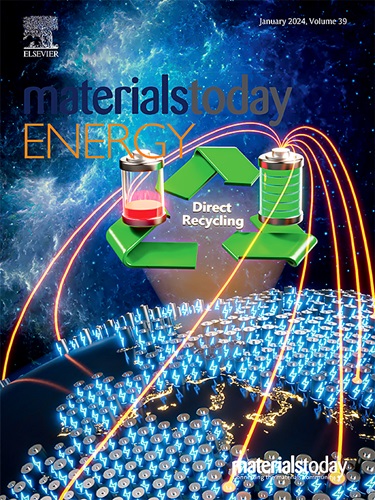通过钛和硫共同修饰实现高镍层状氧化物的表面相稳定性
IF 8.6
2区 材料科学
Q1 CHEMISTRY, PHYSICAL
引用次数: 0
摘要
高镍层状氧化物因其相对较高的容量和较低的成本而成为锂离子电池的理想正极,但由于其循环稳定性较差,因此仍面临着安全问题。本文采用简便的一锅固态法制备了痕量 Ti/S 共掺杂 LiNiCoO。与单独掺杂 Ti 和 S 相比,Ti 和 S 共掺杂以相互促进的方式大大提高了速率能力和内在稳定性。共掺杂样品显示出卓越的速率能力,在 5 C 下达到 170.9 mAh/g,并具有出色的内在稳定性,在室温下循环 200 次后,1 C 下的容量保持率为 88.6%,与原始样品的 132.2 mAh/g 和 61.6% 形成鲜明对比。性能的提高可归因于硫形成了更强的 Ti-O 键和更薄的岩盐保护层,钛改性增强了稳定性,以及硫激活了额外的氧化还原反应。通过掺杂不同的外来元素而产生的相互促进的增强效应,为电极材料性能的提高开辟了一种全新而独特的设计策略。本文章由计算机程序翻译,如有差异,请以英文原文为准。
Surface phase stability of high-nickel layered oxides by titanium and sulfur co-modifications
High-nickel layered oxides are promising cathodes for lithium-ion batteries due to relatively high capacity and low cost, which however are still faced with safety issues because of poor stability against cycling. Herein, a facile one-pot solid-state method is employed for preparation of trace Ti/S co-doped LiNiCoO. Ti and S co-doping enhances both rate capability and intrinsic stability greatly in a mutually promoting manner compared with individual Ti and S doping. The co-doped samples show excellent rate capability with 170.9 mAh/g at 5 C and superior intrinsic stability with a capacity retention of 88.6% at 1 C after 200 cycles at room temperature, in sharp contrast with 132.2 mAh/g and 61.6% for the pristine samples. Full cells achieve excellent long-term stability with a retention of 92.7% after 400 cycles at 1 C. The improved performance can be ascribed to the formation of stronger Ti–O bonds and of a thin rock-salt protective layer enabled by sulfur with the stability enhanced by Ti modifications, and the activation of extra redox reactions triggered by sulfur. The mutually promoting enhancement effect by doping different alien elements opens a new and unique design strategy for performance improvement of electrode materials.
求助全文
通过发布文献求助,成功后即可免费获取论文全文。
去求助
来源期刊

Materials Today Energy
Materials Science-Materials Science (miscellaneous)
CiteScore
15.10
自引率
7.50%
发文量
291
审稿时长
15 days
期刊介绍:
Materials Today Energy is a multi-disciplinary, rapid-publication journal focused on all aspects of materials for energy.
Materials Today Energy provides a forum for the discussion of high quality research that is helping define the inclusive, growing field of energy materials.
Part of the Materials Today family, Materials Today Energy offers authors rigorous peer review, rapid decisions, and high visibility. The editors welcome comprehensive articles, short communications and reviews on both theoretical and experimental work in relation to energy harvesting, conversion, storage and distribution, on topics including but not limited to:
-Solar energy conversion
-Hydrogen generation
-Photocatalysis
-Thermoelectric materials and devices
-Materials for nuclear energy applications
-Materials for Energy Storage
-Environment protection
-Sustainable and green materials
 求助内容:
求助内容: 应助结果提醒方式:
应助结果提醒方式:


